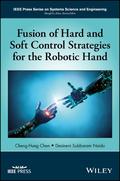Fusion of Hard and Soft Control Strategies for the Robotic Hand
IEEE Series on Systems Science and Engineering

1. Auflage November 2017
256 Seiten, Hardcover
Praktikerbuch
An in-depth review of hybrid control techniques for smart prosthetic hand technology by two of the world's pioneering experts in the field
Long considered the stuff of science fiction, a prosthetic hand capable of fully replicating all of that appendage's various functions is closer to becoming reality than ever before. This book provides a comprehensive report on exciting recent developments in hybrid control techniques--one of the most crucial hurdles to be overcome in creating smart prosthetic hands.
Coauthored by two of the world's foremost pioneering experts in the field, Fusion of Hard and Soft Control Strategies for Robotic Hand treats robotic hands for multiple applications. Itbegins withan overview of advances in main control techniques that have been made over the past decade before addressing the military context for affordable robotic hand technology with tactile and/or proprioceptive feedback for hand amputees. Kinematics, homogeneous transformations, inverse and differential kinematics, trajectory planning, and dynamic models of two-link thumb and three-link index finger are discussed in detail. The remainder of the book is devoted to the most promising soft computing techniques, particle swarm optimization techniques, and strategies combining hard and soft controls.
In addition, the book:
* Includes a report on exciting new developments in prosthetic/robotic hand technology, with an emphasis on the fusion of hard and soft control strategies
* Covers both prosthetic and non-prosthetic hand designs for everything from routine human operations, robotic surgery, and repair and maintenance, to hazardous materials handling, space applications, explosives disposal, and more
* Provides a comprehensive overview of five-fingered robotic hand technology kinematics, dynamics, and control
* Features detailed coverage of important recent developments in neuroprosthetics
Fusion of Hard and Soft Control Strategies for Robotic Hand is a must-read for researchers in control engineering, robotic engineering, biomedical sciences and engineering, and rehabilitation engineering.
List of Tables xvii
1 Introduction 1
1.1 Relevance to Military 2
1.2 Control Strategies 3
1.2.1 Prosthetic/Robotic Hands 3
1.2.2 Chronological Overview 5
1.2.3 Overview of Main Control Techniques Since 2007 15
1.2.4 Revolutionary Prosthesis 18
1.3 Fusion of Intelligent Control Strategies 19
1.3.1 Fusion of Hard and Soft Computing/Control Strategies 19
1.4 Overview of Our Research 22
1.5 Developments in Neuroprosthetics 23
1.6 Chapter Summary 24
2 Kinematics and Trajectory Planning 47
2.1 Human Hand Anatomy 48
2.2 Forward Kinematics 49
2.2.1 Homogeneous Transformations 50
2.2.2 Serial -Link Revolute-Joint Planar Manipulator 54
2.2.3 Two-Link Thumb 58
2.2.4 Three-Link Index Finger 60
2.2.5 Three-Dimensional Five-Fingered Robotic Hand 62
2.3 Inverse Kinematics 66
2.3.1 Two-Link Thumb 66
2.3.2 Three-Link Fingers 67
2.3.3 Fingertip Workspace 68
2.3.3.1 Two-Link Thumb and Three-Link Index Finger 69
2.3.3.2 Five-Fingered Robotic Hand 70
2.4 Differential Kinematics 70
2.4.1 Serial -Link Revolute-Joint Planar Manipulator 71
2.4.1.1 Some Properties of RotationMatrices 72
2.4.1.2 Rigid Body Kinematics 74
2.4.2 Two-Link Thumb 78
2.4.3 Three-Link Index Finger 79
2.5 Trajectory Planning 80
2.5.1 Trajectory Planning Using Cubic Polynomial 81
2.5.2 Trajectory Planning Using Cubic Bezier Curve 82
2.5.3 Simulation Results of Trajectory Paths 84
3 Dynamic Models 93
3.1 Actuators 93
3.1.1 Electric DC Motor 93
3.1.2 Mechanical Gear Transmission 94
3.2 Dynamics 96
3.3 Two-Link Thumb 96
3.4 Three-Link Index Finger 99
4 Soft Computing/Control Strategies 105
4.1 Fuzzy Logic 105
4.2 Neural Network 108
4.3 Adaptive Neuro-Fuzzy Inference System 108
4.4 Tabu Search 113
4.4.1 Tabu Concepts 113
4.4.2 Enhanced Continuous Tabu Search 114
4.4.2.1 Initialization of Parameters 114
4.4.2.2 Diversification 114
4.4.2.3 Selecting the Most Promising Area 115
4.4.2.4 Intensi cation 116
4.5 Genetic Algorithm 118
4.5.1 Basic GA Procedures 118
4.6 Particle Swarm Optimization 121
4.6.1 Basic PSO Procedures and Formulations 121
4.6.2 Five Different PSO Techniques 125
4.6.3 Uniform Distribution and Normal Distribution 128
4.7 Adaptive Particle Swarm Optimization 130
4.7.1 APSO Procedures and Formulations 130
4.7.2 Changed/Unchanged Velocity Direction 134
4.8 Condensed Hybrid Optimization 136
4.9 Simulation Results and Discussion 137
4.9.1 PSO Dynamics Investigation 137
4.9.1.1 Benchmark Problems 137
4.9.1.2 Selection of Parameters 138
4.9.1.3 Simulations 139
4.9.2 APSO to Multiple Dimensional Problems 145
4.9.3 PSO in Other Biomedical Applications 149
4.9.3.1 Leukocyte Adhesion Molecules Modeling 149
4.9.4 CHO to Multiple Dimensional Problems 151
5 Fusion of Hard and Soft Control Strategies I 161
5.1 Feedback Linearization 161
5.1.1 State Variable Representation 162
5.2 PD/PI/PID Controllers 163
5.2.1 PD Controller 164
5.2.2 PI Controller 165
5.2.3 PID Controller 165
5.3 Optimal Controller 167
5.3.1 Optimal Regulation 167
5.3.2 Linear Quadratic Optimal Control with Tracking System 167
5.3.3 A Modified Optimal Control with Tracking System 168
5.4 Adaptive Controller 170
5.5 Simulation Results and Discussion 172
5.5.1 Two-Link Thumb 172
5.5.2 Three-Link Index Finger 175
5.5.3 Three-Dimensional Five-Fingered Robotic Hand 177
5.5.3.1 PID Control 177
5.5.3.2 Optimal Control 178
5.A Appendix: Regression Matrix 198
6 Fusion of Hard and Soft Control Strategies II 203
6.1 Fuzzy-Logic-Based PD Fusion Control Strategy 203
6.1.1 Simulation Results and Discussion 207
6.2 Genetic-Algorithm-Based PID Fusion Control Strategy 212
6.2.1 Simulation Results and Discussion 213
7 Conclusions and Future Work 223
7.1 Conclusions 223
7.2 Future Directions 225
Index 229
Epilogue 231
DESINENI SUBBARAM NAIDU, PhD, Life Fellow IEEE, is the Minnesota Power Jack F. Rowe Endowed Chair and Professor of Electrical Engineering at the University of Minnesota, Duluth, USA. He pioneered several notable interdisciplinary research projects including Smart Prosthetic Hand Technology at the Measurement and Control Engineering Research Center (MCERC), Idaho State University, Pocatello, Idaho, USA


